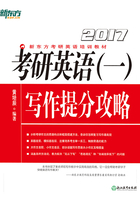
第二章 考研写作,怎样复习最有效
一 写作复习中的几个误区
(一) 存在侥幸心理,想“蒙混过关”
背诵是写作考试的基本准备形式,毕竟,对于基础薄弱的考生而言,考前背诵和默写是最有效的提分途径。但是一些考生想用背一个固定不变的模式,套用几个“大词”的方法混过考试;还有些考生想当然地认为,在很短的时间内,阅卷人只是粗略地浏览作文,感觉“还行”就会给出高分。这种备考思想产生的原因是存在侥幸心理,其备考方针从初始阶段就是错误的。
这样准备考研,你“混”得过去吗?答案当然是否定的。
■请看一个学生的习作例文:
What a compendious and compelling image it is!As we can see from the cartoon,the cartoonist depicts a thought-provoking issue in an extremely exaggerated way.Interesting enough,(简要描述)What would the author like to express in such a humorous and exaggerated way?
It is self-evident that the topic of(主题词)revealed in the picture is thoughtful.Any discussion about it is inevitable coming down to the following causes.To begin with,the economic reform and scientific and technological progress in the past 30 years has led to extraordinary changes to our society and lives.Meanwhile,there are some positive/negative effects as well.For instance,the problem of(主题词)has been neglected by many of us.Secondly,huge changes have taken place,to which the corresponding law (rule/morality/mechanism/consensus)has not adapted.The subject of(主题词)has existed for a long time which should be paid enough attention to.
Therefore,on the one hand,the vigorous propaganda of mass media,such as TV,radio and website,is the desideratum.On the other hand,we should appeal to the authorities concerned to make some appropriate adjustment to adapt to similar phenomena.Just thinking over the long run,(主题词)is not only beneficial for us,but also good for the whole society.
在这篇充斥着长句难词的“范文”中,第一段涉及题目图画描述的只有一个句子,而且用问句结尾,没有对图画文字暗示进行翻译。第二段只为主题词留了三个填空位置,其他部分多为套话,如the economic reform and scientific and technological progress in the past 30 years has led to extraordinary changes to our society and lives.第三段也只给主题词留了一个位置,其他部分都是一字不改地套写。不敢想象,这样一篇只有一个描述句、几个主题词填空的“范文”,到了阅卷人手中,最后能得多少分。
(二) 背得多,练得少
提升写作能力最有效的途径之一就是背诵。考生通过背诵可以培养语感,还可以熟悉语法和单词。范文背得熟练了,朗朗上口了,慢慢也就会写了。但是背范文也有它的缺点,主要体现在两个方面:1)对于口语基础较差的考生来说,发音是个很大的问题,如果读不出来,当然也就背不下来;2)背得多,但是练得少,写作时容易出现语法、单词错误,甚至写错了也不自知。
■请看一个学生的感谢信例文:
Last mouth,I was traveling in Shanghai.I have a bad cold and fever,because I couldn't get used to the gold weather there.
译文:上个月,我在上海旅游,得了重感冒,还发了烧,因为我不适应那里寒冷的天气。
写作点评:这是笔者批改的一份学生习作,在短短的一行英文中,就出现了拼写、语法和笔误三种错误。将“上个月”(last month)误写成last mouth,将“我得了重感冒”(I had a bad cold)误写成I have a bad cold,将“寒冷的天气”(cold weather)误写成gold weather。
■再看一个大作文的段落,写作题目是“中国父母对儿女的过度期待”:
Over-expectation of Some Chinese Parents towards their Children
Recently,the issue of over-expectation has become increasingly important.More and more social forces pay attention to it.The media,including radio,television and Internet,is supposed to give a wide coverage to this phenomenon.Another is the government intervention:laws should be passed to control the phenomenon of over-expectation.Otherwise,it will become even worse in our society.
译文:近来,过度期待问题变得越来越重要。越来越多的社会力量对此表示关注。媒体,包括广播、电视和互联网,应该对这种现象进行广泛报道。另外就是政府干预,应该制定法律控制过度期待现象,不然,它就会在我们的社会里变得越来越严重。
写作点评:相信大家读了上文后都会觉得内容非常别扭。父母对儿女的过度期待属于家庭教育问题,和“媒体报道”“政府干预”有什么关系呢?明显是考生想当然地将自己背过的句子进行生搬硬套,而没有察觉文不对题。
考生如果将大作文背混了,会意识不到和社会话题相关的语句无法应对家庭教育方面的题材;如果将小作文背混了,又没有检查,则会出现低级错误。因此,提倡大家不要光背诵范文,还要多动笔练习写作,将背诵与运用结合起来。如果平时加强练习,出现拼写、语法等错误后,就可以通过检查修改及时纠正。如果平时练习少,这种错误在考试中出现了也不知道,最终会影响得分。
(三) 无效背诵多
不可否认,对于考研学生而言,范文背诵是最简单、直接、有效的写作备考方式,毕竟“熟读唐诗三百首,不会作诗也会吟”。可是这句话里面有个问题,那就是即使你能够熟读三百首唐诗,还是不会作诗,充其量只会吟诗。通俗一些的说法就是:“你背了不少别人的诗歌,但自己还是不会写诗,只能够朗诵出几句别人的诗。”考研写作也是同样的道理,考生背了不少文章,可是自己写作的时候,不是思路枯竭,就是无从下笔,即使写出几句套话,还是错误百出。原因很简单,以前进行的都是无效背诵。无效背诵主要体现在以下几个方面:
1.范文首尾句的无效背诵
背范文就要背首尾句。随着范文背诵量的增加,首尾句也在增加,结果是首尾句背了很多,构成重复背诵,而段落中最重要的的例证、原因分析和词语搭配却在一定程度上被忽略了。从表面上看,考生似乎十分用功,而实际上无效背诵多、有效背诵少。说得通俗一些:“花架子”多、“干货”少。
以下语句都可以用于描述段首句的写法,即使将它们都背下来,也不可能同时应用于一篇作文的开篇,这样的背诵是不是浪费了不少时间呢?
1)The picture above foresees a bright future/disturbing future of our society.以上图画预示着我们社会的美好未来(或令人担忧的前景)。
2)What does the author intend to convey by providing the picture above?作者提供上述图画,想要向我们说明什么呢?
3)By providing the picture above,the author tends to highlight certain thought-provoking social phenomenon.作者通过提供上述图画,似乎是要揭示某种引人深思的社会现象。
4)The drawing above does demonstrate certain thought-provoking social phenomenon.以上图画的确反映了某种引人深思的社会现象。
5)No other drawings can better illustrate a kind of disturbing social phenomenon than this one.恐怕没有哪幅图画能比这幅更好地反映一种令人担忧的社会现象了。
事实上,考生只需选择其中一两个觉得最好用的句式记住即可。
2.关联词的无效背诵
背范文就要涉及关联词,例如,读者已经学会了“首先”“其次”“最后”的说法,即First...Second...Third and last...而到了另一篇范文又变成了To begin with...In addition...Last but not least...可是每次考试只写一篇大作文,这些词组能够同时用在一篇文章里的可能性很小。同理,在第二段如果使用for instance(举例),就没有必要再背很多同义词,如illustrate,demonstrate,prove,show...第三段如用to sum up做总结,则没必要再背太多的近义表达,如to conclude,in conclusion,in short,in a nutshell等。
总之,对于首尾句和关联词,不如只选择其中的一到两组先背诵熟练,然后反复演练。无论用词简洁还是复杂,在阅卷人看来没有什么区别,不会影响分数的评定。真正影响分数评定的是:1)是否切题;2)内容是否具体;3)阅读时是否顺畅;4)词汇搭配是否恰当。
3.空话的无效背诵
除了首尾句和关联词,一些考生还经常储备这样的一些整句:
1)Simple as the picture is,it does account for some social phenomenon in our country.尽管这幅图画很简单,但是它的确解释了我国的一些社会现象。
2)At the first glimpse,you will find that the cartoon seems superficial,but at a second thought,it is indeed instructive and thought-provoking.乍看起来,这幅漫画似乎很肤浅,但是仔细思考,就会发现它其实很有教育意义,引人深思。
3)Doesn't the cartoon above highlight certain social issue in our country?难道以上漫画没有反映出我国的某些社会问题吗?
4)What does the cartoonist intend to convey by depicting this picture?漫画家绘制以上图画是为了表达什么呢?
这些句子看似十分“通用”,但是都有一个特点:和文章的主题毫无关联,有的还采用了疑问句结构。这种类型的句子就是所谓的“套话句”或“模板句”。背会其中的一个,考场上“救急”还是可以的,但是如果这种类型的句子用得过多,阅卷者就会发现模板的痕迹,给出低分。